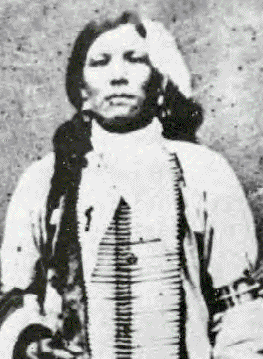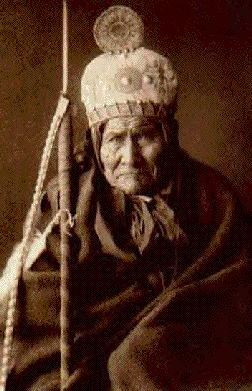Eholi Wohali ©









 Chief Crazy Horse (Tashunkewitko)
"A very great vision is needed and the man who has it must follow it as the
eagle seeks the deepest blue of the sky. I was hostile to the white man...we
preferred hunting to a life of idleness on our reservations. At times we did
not get enough to eat and we were not allowed to hunt. All we wanted
was peace and to be left alone. Soldiers came and destroyed our villages.
Then Long Hair (Custer) came...They say we massacred him, but he
would have done the same to us. Our first impulse was to escape but we
were so hemmed in we had to fight."
Crazy Horse (Tashunkewitko) was born on the Republican River about 1845.
He was killed at Fort Robinson, Nebraska, in 1877, so that he lived barely thirty-three years. He was an uncommonly handsome man. He was physically perfect, an Apollo in symmetry. Furthermore he was a true type of American Indian refinement and grace. He was modest and courteous as Chief Joseph; the difference is that he was a born warrior, while Joseph was not. However, he was a gentle warrior, a true brave, who stood for the highest ideal of the Sioux. Notwithstanding all that biased historians have said of him, it is only fair to judge a man by the estimate of his own people rather than that of his enemies. Chief Crazy Horse was carefully brought up according to the tribal customs. At that period the Sioux prided themselves on the training and development of their sons and daughters, and not a step in that development was overlooked as an excuse to bring the child before the public by giving a feast in its honor. Big-heartedness, generosity, courage, and self-denial are the qualifications of a public servant, and the American Indian was keen to follow this ideal. Crazy Horse loved horses, he became a fine horseman and accompanied his father on buffalo hunts, holding the pack horses while the men chased the buffalo and thus gradually learning the art. At the age of sixteen he joined a war party against the Gros Ventres. He was well in the front of the charge, and at once established his bravery by following closely one of the foremost Sioux warriors, by the name of Hump, drawing the enemy's fire and circling around their advance guard. Suddenly Hump's horse was shot from under him, and there was a rush of warriors to kill or capture him while down. But amidst a shower of arrows the youth leaped from his pony, helped his friend into his own saddle, sprang up behind him, and carried him off in safety, although they were hotly pursued by the enemy. Thus he associated himself in his maiden battle with the wizard of Indian warfare, and Hump, who was then at the height of his own career, pronounced Crazy Horse the coming warrior of the Teton Sioux. He was much sought after by his youthful associates, but was noticeably reserved and modest; yet in the moment of danger he at once rose above them all -- a natural leader! He attained his majority at the crisis of the difficulties between the United States and the Sioux. Even before that time, Crazy Horse had already proved his worth to his people in Indian warfare. He had risked his life again and again, and in some instances it was considered almost a miracle that he had saved others as well as himself. He was no orator nor was he the son of a chief. His success and influence was purely a matter of personality. He had never fought the whites up to this time, and indeed no "coup" was counted for killing or scalping a white man. Young Crazy Horse was twenty-one years old when all the Teton Sioux chiefs (the western or plains dwellers) met in council to determine upon their future policy toward the invader. Most of the chiefs advocated a strong resistance. There were a few influential men who desired still to live in peace, and who were willing to make another treaty. Among these were White Bull, Two Kettle, Four Bears, and Swift Bear. Even Spotted Tail, afterward the great peace chief, was at this time with the majority, who decided in the year 1866 to defend their rights and territory by force. Attacks were to be made upon the forts within their country and on every trespasser on the same. Crazy Horse took no part in the discussion, but he and all the young warriors were in accord with the decision of the council. The attack on Fort Phil Kearny was the first fruits of the new policy, and here Crazy Horse was chosen to lead the attack on the woodchoppers, designed to draw the soldiers out of the fort, while an army of six hundred lay in wait for them. The success of this stratagem was further enhanced by his masterful handling of his men. Sitting Bull looked to him as a principal war leader, and even the Cheyenne chiefs, allies of the Sioux, practically acknowledged his leadership. Yet during the following ten years of defensive war he was never known to make a speech, though his teepee was the rendezvous of the young men. He was depended upon to put into action the decisions of the council, and was frequently consulted by the older chiefs. Like Osceola, he rose suddenly; like Tecumseh he was always impatient for battle; like Pontiac, he fought on while his allies were suing for peace, and like Grant, the silent soldier, he was a man of deeds and not of words. He won every battle that he undertook, with the exception of one or two occasions when he was surprised in the midst of his women and children, and even then he managed to extricate himself in safety from a difficult position. Early in the year 1876, the American Indians came together and formed a series of encampments stretching out from three to four miles, each band keeping separate camp. On June 17, scouts came in and reported the advance of a large body of troops under General Crook. The council sent Crazy Horse with seven hundred men to meet and attack him. These were nearly all young men, many of them under twenty, the flower of the hostile Sioux. Crazy Horse charged with his bravest men, in an attempt to bring the troops into the open, but he succeeded only in drawing their fire. Toward afternoon he withdrew, and returned to camp disappointed. His scouts remained to watch Crook's movements, and later brought word that he had retreated to Goose Creek and seemed to have no further disposition to disturb the Sioux. The Indians now crossed the divide between the Tongue and the Little Big Horn, where they felt safe from immediate pursuit. Here, with all their precautions, they were caught unawares by General Custer, in the midst of their midday games and festivities, while many were out upon the daily hunt. On this twenty-fifth of June, 1876, Crazy Horse was watching a game of ring-toss when the warning came from the southern end of the camp of the approach of troops. The Sioux and the Cheyennes were "minute men", and although taken by surprise, they instantly responded. Crazy Horse had quickly saddled his favorite war pony and was starting with his young men for the south end of the camp, when a fresh alarm came from the opposite direction, and looking up, he saw Custer's force upon the top of the bluff directly across the river. As quick as a flash, he took in the situation -- the enemy had planned to attack the camp at both ends at once; and knowing that Custer could not ford the river at that point, he instantly led his men northward to the ford to cut him off. The Cheyennes followed closely. In a very few minutes, this wild general of the plains had outwitted one of the most brilliant leaders of the Civil War and ended at once his military career and his life. In this dashing charge, Crazy Horse snatched his most famous victory out of what seemed frightful peril, for the Sioux could not know how many were behind Custer. He was caught in his own trap. To the soldiers it must have seemed as if the Indians rose up from the earth to overwhelm them. They closed in from three sides and fought until not a white man was left alive. From time to time, delegations of friendly Indians were sent to him, to urge him to come in to the reservation, promising a full hearing and fair treatment. For some time he held out, but the rapid disappearance of the buffalo, their only means of support, weighed with him more than any other influence. In July, 1877, he was finally prevailed upon to come in to Fort Robinson, Nebraska, with several thousand Indians, most of them Ogallala and Minneconwoju Sioux, on the distinct understanding that the government would hear and adjust their grievances. At this juncture General Crook proclaimed Spotted Tail, who had rendered much valuable service to the army, head chief of the Sioux, which was resented by many. The attention paid Crazy Horse was offensive to Spotted Tail and the Indian scouts, who planned a conspiracy against him. They reported to General Crook that the young chief would murder him at the next council, and stampede the Sioux into another war. He was urged not to attend the council and did not, but sent another officer to represent him. Meanwhile the friends of Crazy Horse discovered the plot and told him of it. His reply was, "Only cowards are murderers." His wife was critically ill at the time, and he decided to take her to her parents at Spotted Tail agency, whereupon his enemies circulated the story that he had fled, and a party of scouts was sent after him. They overtook him riding with his wife and one other but did not undertake to arrest him, and after he had left the sick woman with her people he went to call on Captain Lea, the agent for the Brules, accompanied by all the warriors of the Minneconwoju band. The scouts who had followed Crazy Horse from Red Cloud agency were advised not to show themselves, as some of the warriors had urged that they be taken out and horsewhipped publicly. Under these circumstances Crazy Horse again showed his masterful spirit by holding these young men in check. He said to them in his quiet way: "It is well to be brave in the field of battle; it is cowardly to display bravery against one's own tribesmen. These scouts have been compelled to do what they did; they are no better than servants of the white officers. I came here on a peaceful errand." The captain urged him to report at army headquarters to explain himself and correct false rumors, and on his giving consent, furnished him with a wagon and escort. He went of his own accord, either suspecting no treachery or determined to defy it. When he reached the military camp, Little Big Man walked arm-in-arm with him, and his cousin and friend, Touch-the-Cloud, was just in advance. After they passed the sentinel, an officer approached them and walked on his other side. He was unarmed but for the knife which is carried for ordinary uses by women as well as men. Unsuspectingly he walked toward the guardhouse, when Touch-the-Cloud suddenly turned back exclaiming: "Cousin, they will put you in prison!"
"Another white man's trick! Let me go! Let me die fighting!" cried Crazy Horse. He stopped and tried to free himself and draw his knife, but both arms were held fast by Little Big Man and the officer. While he struggled, a soldier thrust him with his bayonet from behind. (This is the epitomy of the cowardice of the Palefaces, as they didn't have the balls to face him face to face) The wound was mortal, and he died in the course of that night, his old father singing the death song over him and afterward carrying away the body, which they said must not be further polluted by the touch of a white man. They hid it somewhere in the Bad Lands, his resting place to this day. Thus died one of the ablest and truest American Indians. His life was ideal; his record clean. He was never involved in any of the numerous massacres on the trail, but was a leader in practically every open fight. Such characters as those of Crazy Horse and Chief Joseph are not easily found among so-called civilized people. The reputation of great men is apt to be shadowed by questionable motives and policies, but here are two pure patriots, as worthy of honor as any who ever breathed the Great Creator's air in the wide spaces of a new world.
|
Geronimo (Goyathlay, " One Who Yawns"
(1829-1890)
Chiricahua (not Apache) Chief
















